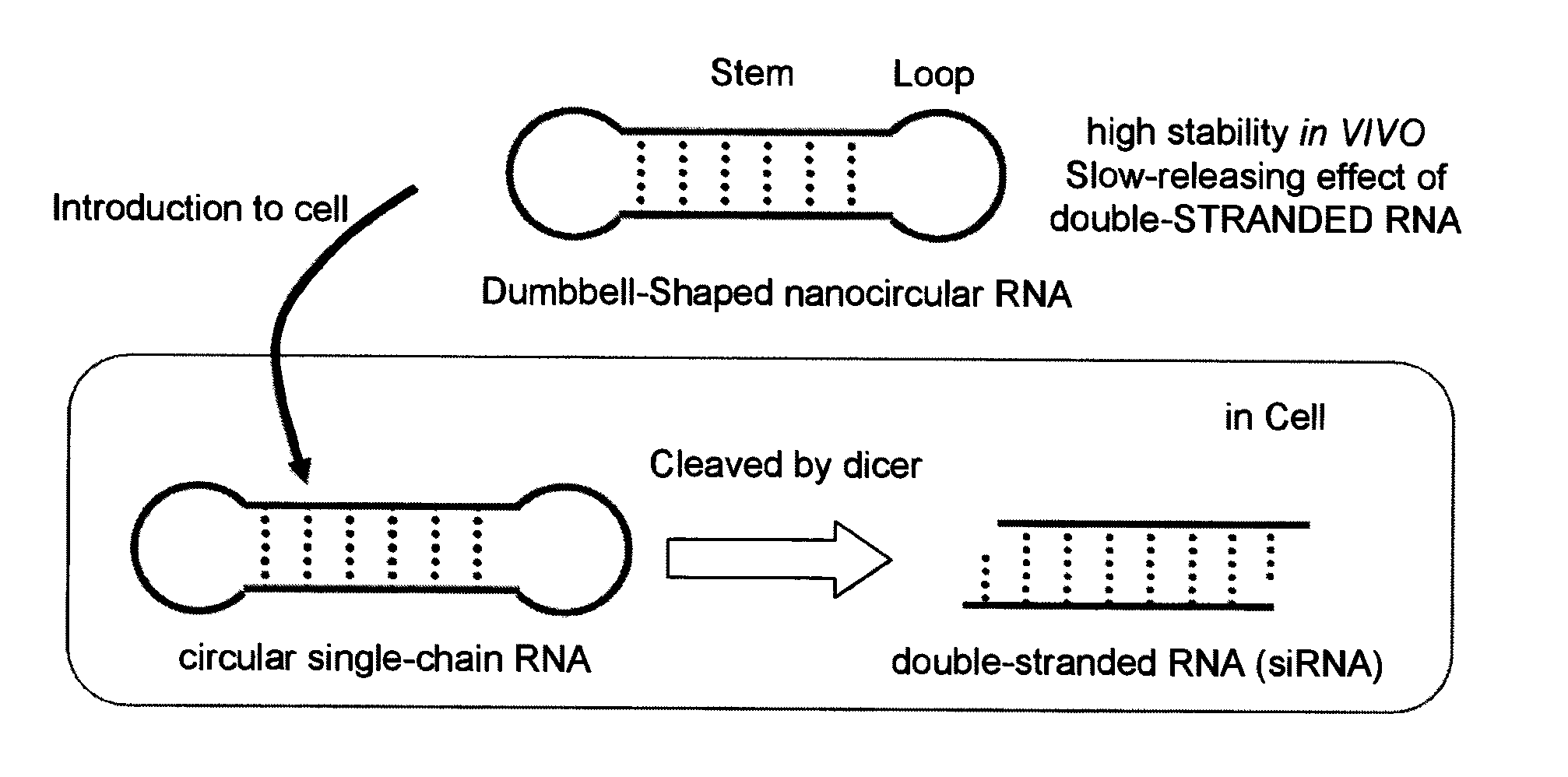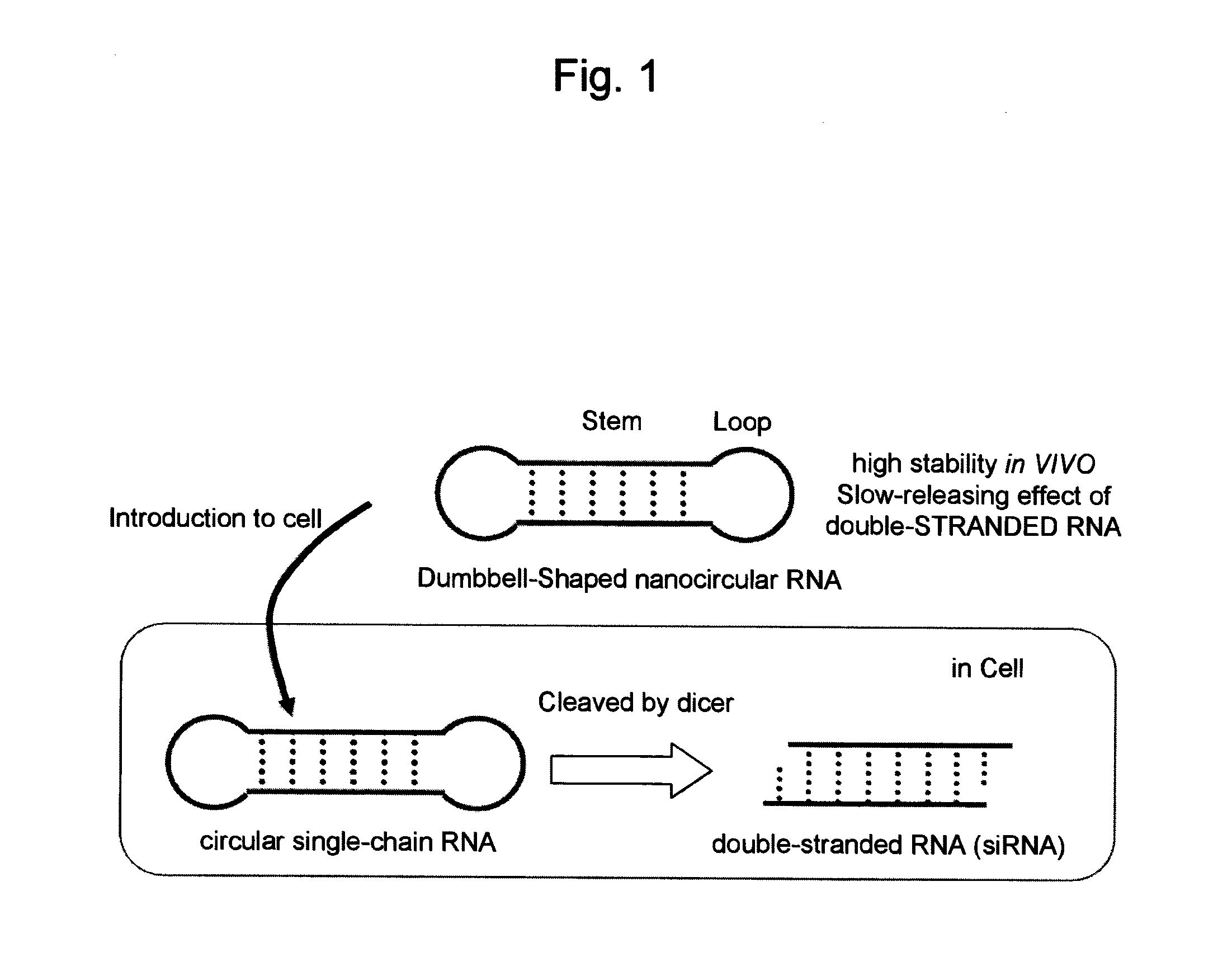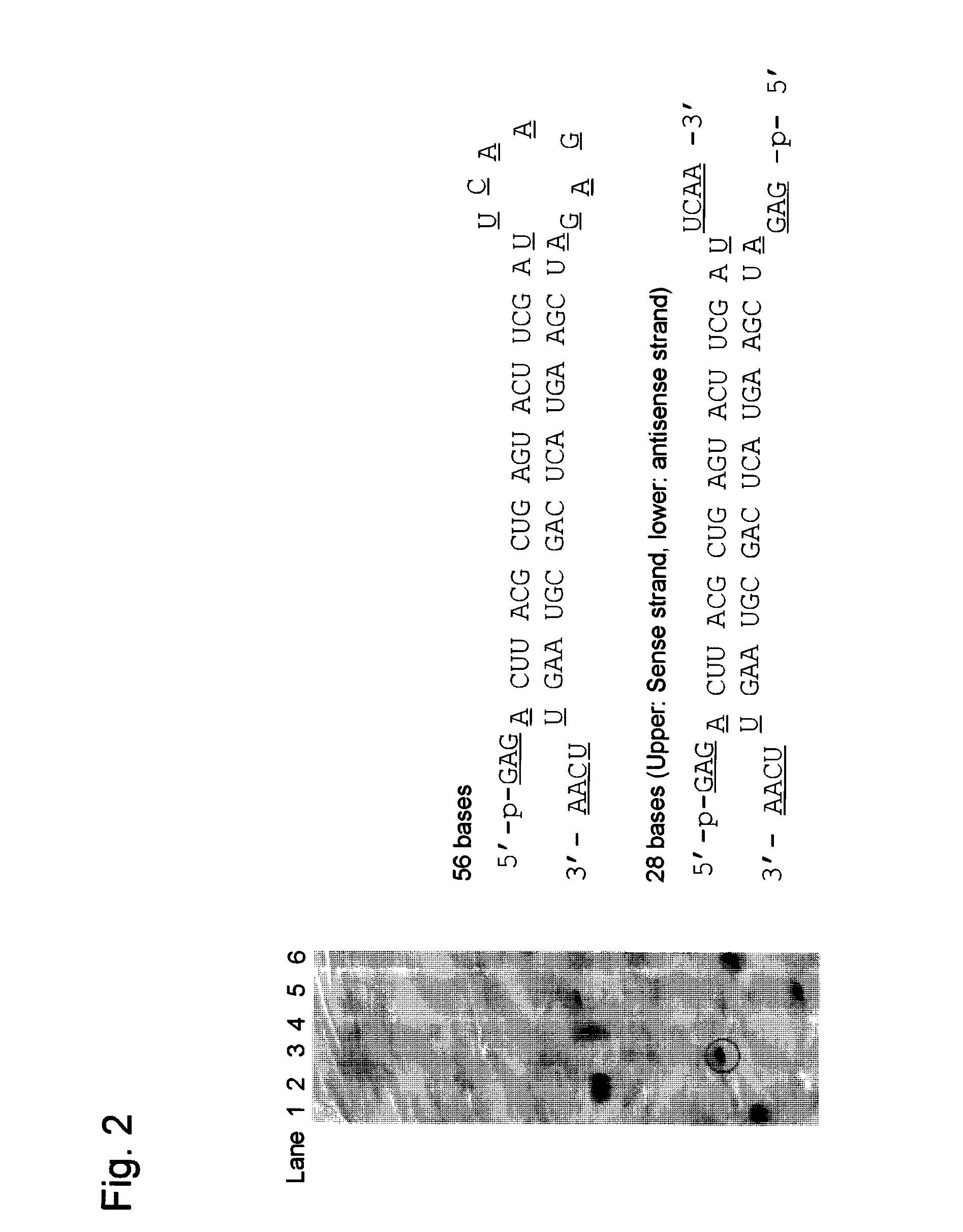Single-chain circular RNA and method of producing the same
a single-chain, circular technology, applied in the direction of artificial cell constructs, organic chemistry, drug compositions, etc., can solve the problems of chemically synthesized double-stranded rnas being unstable in vivo, reducing biological activity, and plasmid vector methods have a problem of safety to a human body, etc., to achieve efficient production, excellent stability, and sustainability and slow-releasing properties
- Summary
- Abstract
- Description
- Claims
- Application Information
AI Technical Summary
Benefits of technology
Problems solved by technology
Method used
Image
Examples
example 1
Preparation of a Dumbbell-Shaped RNA
[0068]5′-phosphorylated RNAs serving as raw materials for dumbbell-shaped RNAs were all synthesized on DNA synthesizer (GeneWorld H8-SE) in accordance with the phosphoroamidite method. Protected TBDMS (Proligo Corp.) was used for RNA amidites, and Chemical Phosphorylation Reagent (Glen Research Corp.) was used for 5′-phosphorylation. Deprotection was performed by the ordinary method, followed by PAGE-purification. The sequences of the synthesized RNA are shown in SEQ ID NO: 1 (sense strand, 28 mer), SEQ ID NO: 2 (antisense strand, 28 mer), SEQ ID NO: 3 (56 mer), and in FIG. 2. Moreover, in the RNA sequences shown in FIG. 2, the underlined sequences are sequences which form the loop region of a dumbbell-shaped RNA.
[0069]Subsequently, enzymatic reaction was performed in the mixture of 2 μM RNA double strand, 2.0 units / μl T4 RNA ligase, 0.006% BSA, 25% PEG6000, 50 mM Tris-HCl (pH 7.5), 10 mM MgCl2, 10 mM DTT and 1 mM ATP in a total volume of 25 μl.
[0...
example 2
Examination of the Stem Length of the Dumbbell-Shaped RNA
[0074]RNAs represented by SEQ ID NOS: 4 through 13 were synthesized by the above DNA synthesizer. SEQ ID NOS: 4 and 5 form a double-stranded RNA which forms 18 base pairs (siRNA-1), SEQ ID NOS: 6 and 7 form a dumbbell-shaped RNA whose stem length is 19 bases (Db-19), SEQ ID NOS: 8 and 9 form a dumbbell-shaped RNA whose stem length is 23 bases (Db-23), SEQ ID NOS: 10 and 11 form a dumbbell-shaped RNA whose stem length is 27 bases (Db-27), and SEQ ID NOS: 12 and 13 form a dumbbell-shaped RNA whose stem length is 31 bases (Db-31) (FIG. 3).
[0075]An enzymatic reaction was performed in the composition of 2 μM RNA double strand, 1.0 units / μl T4 RNA ligase, 0.006% BSA, 25% PEG6000, 50 mM Tris-HCl (pH 7.5), 10 mM MgCl2, 10 mM DTT and 1 mM ATP in a reaction volume ranging from 1.5 to 2.5 ml.
[0076]More specifically, 5′-phosphorylated double-stranded RNA was dissolved in a buffer (2× buffer, half of the amount of final reaction solution) ...
example 3
RNA Interference Effect of the Dumbbell-Shaped RNA
[0080]RNA interference effect of the above dumbbell-shaped RNAs (Db-19, Db-23, Db-27 and Db-31) was evaluated by an inhibition experiment of the expression of firefly luciferase reporter gene pGL3.
[0081]NIH 3T3 cells (Riken Cell Bank) were cultured in DMEM (GIBCO) medium containing 10% FCS at 37° C. in 5% CO2, and a 100 μl aliquot of the culture was inoculated to each well of a 96-well plate at a concentration of 1.6×104 cells / well. The sample was further cultured at 37° C. in 5% CO2 for 39 hours to give approximately 70% confluence. The cells were then cotransfected with 2 kinds of plasmid vectors (pGL3-Control and pRL-TK (for internal standard), from Promega Corp.) and each kind of RNAs, using the transfection reagent GeneSilencer (Genlantis Inc.) in accordance with the protocol attached to the transfection reagent. The concentration conditions at the time of transfection are as follows.
[0082]0.2 μg pGL3-Control / 0.02 μg pRL-TK / 25 n...
PUM
| Property | Measurement | Unit |
|---|---|---|
| total volume | aaaaa | aaaaa |
| temperature | aaaaa | aaaaa |
| volume | aaaaa | aaaaa |
Abstract
Description
Claims
Application Information
 Login to View More
Login to View More - R&D
- Intellectual Property
- Life Sciences
- Materials
- Tech Scout
- Unparalleled Data Quality
- Higher Quality Content
- 60% Fewer Hallucinations
Browse by: Latest US Patents, China's latest patents, Technical Efficacy Thesaurus, Application Domain, Technology Topic, Popular Technical Reports.
© 2025 PatSnap. All rights reserved.Legal|Privacy policy|Modern Slavery Act Transparency Statement|Sitemap|About US| Contact US: help@patsnap.com



